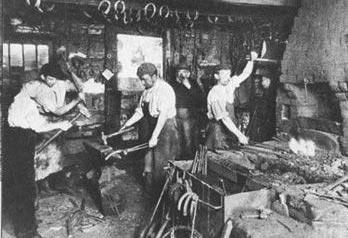
5 minute read
Forging family history
Work in a typical Victorian smithy
Hammering out history
Advertisement
Mick Firth tells how a love of Northumberland and a lifetime in steel-making came together in his family history search, revealing a link to a dynasty of blacksmiths in Ilderton.
Working in the steel industry has been a big part of my life. I was born in Rotherham, South Yorkshire, in 1939. At that time Rotherham, together with Sheffield, was the centre of the steel industry from making raw steel through to manufacturing products and, of course, the birthplace of stainless steel.
I started my working life aged 15 in the steel fabrication industry and later worked as a forge planner for the forging press of the British Steel Corporation Works in Sheffield - the largest in Europe. It is still working and producing large forgings.
It's hard for anyone who hasn't experienced it to imagine the heat, noise, dust and fumes from the electric steel melting furnaces, the casting shop and the forge. Those who have felt the intense heat of the forges have a healthy respect for the men who work there.
Twenty seven years ago my wife

Enid and I stayed in Ilderton for a week's holiday, enjoying the countryside and walking in the Cheviot Hills. Little did we realise then that the village was a link with my own ancestors – men who also knew the heat of the forge.
I started researching my family history about 15 years ago - accessing records on the various family history web sites and buying copies of birth, marriage and death certificates – an expensive business.
It was following my paternal grandmother's family line that brought me back to Ilderton last September, searching for my great, great, great, great grandfather.
The connection starts with my great, great, great grandmother, Margaret Young who was born in Ilderton in 1796. Margaret married a ship's carpenter, William Scott, and lived in Tweedmouth but unfortunately died as a widow in Berwick Workhouse in 1864.
Through Margaret, I found out that her father, John Young, was a blacksmith at Ilderton in 1841 and died there in 1849, so we returned to the village to look for any surviving gravestones for them in St Michael and All Angels Church grounds. How excited was I when within a minute, just left of the main entrance, we found two memorial stones both facing the Roddam Mausoleum. There was little weather erosion and the inscription was legible. One stone is in memory of my great, great, great, great grandfather John Young's family, and the other in memory of his son John’s wife Margaret who died in 1863.
The Young family gravestone While in Ilderton, we were fortunate to meet local residents Gill and Tim Place. Tim, who suggested I tell my story, also pointed out to me the village smithy which still survives.
The Young dynasty of blacksmiths at Ilderton covers 76 years from about 1795 to at least 1871. The family produced eight blacksmiths over four generations, some working in neighbouring villages.
A Victorian Ordnance Survey Map of Northumberland in 1889 shows many villages had a smithy. Obviously in the days of horses and carts a blacksmith was an important part of village life. Working conditions would be hot, noisy and dusty with fumes from the fire not unlike the conditions in the steelworks I described earlier, but of a lesser degree. Not a good working
environment but they were highly skilled artisans and an essential part of Victorian life.
John Young (my great, great, great, great grandfather) was recorded in the 1841 census as being a blacksmith in Ilderton, aged 78. He had probably been a blacksmith at Ilderton since about 1795 as his daughter Margaret was born there in 1796.
John had five sons, two of whom worked as blacksmiths at Ilderton. John (born 1801) was a blacksmith there prior to 1841 and recorded on the 1841 census. By the 1851 census he had become blacksmith at Roseden. His brother Robert (born 1809) also worked at Ilderton prior to 1841 –indicating there was no shortage of work for the family. Robert, however, appears to have emigrated to America and died there in 1843 according to the family gravestone.
Mick Firth Another brother, Benjamin (born 1807), was a blacksmith in Chatton before retiring to Bowsden in 1871. William (born 1812), the youngest brother, was blacksmith at Bowsden for 30 years before turning to farming in Lowick in 1881.
Only the eldest of the five brothers, Thomas (born 1794), avoided the family business, trying his hand at
Lavender Tearooms at Etal
~ Village Shop & Post Office ~ Nr Cornhill~on~Tweed TD12 4TN www.thelavendertearooms.org.uk E-mail:lavendertearooms@btinternet.com Tel: 01890 820761
The smithy at the west end of Ilderton looks relatively unchanged from the outside but the old fire place has had a concrete base put over the original so little remains of the old workshop.

being a hawker in Wooler (1841 census), an earthware dealer in Alnwick (1851 census) and a shepherd at Callaly and Yetlington (1861 census).
The third generation of Youngs at Ilderton smithy included another John Young (born 1827) and his brother Thomas (born 1836). After their father John (1801) moved to Roseden they worked together at Ilderton, being recorded on the 1851 census. John stayed for more than 20 years and Thomas until 1861 when he left to work in Newcastle where he was recorded as being a blacksmith in Elswick in 1871.
By 1881 the last John Young had left Ilderton to become blacksmith at Lilburn, working with his son Robert William Young who at 14 years of age was apprentice blacksmith.
By 1891 John and his son Robert had made the move into farming at Elyhaugh. The smithy at Ilderton continued as a blacksmith's shop with five more blacksmiths working there up until 1911 when the census records no blacksmiths at Ilderton. Obviously there were blacksmiths prior to 1796 but finding out who they were is not an easy task.
My research journey has been an interesting and enlightening one. Although I knew that some of my ancestors came from Tweedmouth and County Durham (the Straughans) I little realised that I had a wonderful family history in Northumberland .
My wife Enid and I have always liked Northumberland, its historical features, coast and hills - perhaps it is the DNA of the Youngs deep in my veins that draws me to it! One other significant factor I found during my research is that there are lots of Young, Straughan and Scott families in Glendale. How many more relatives do I have there?










